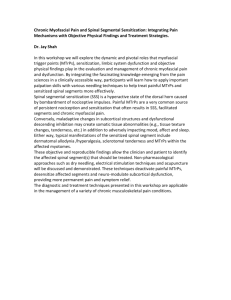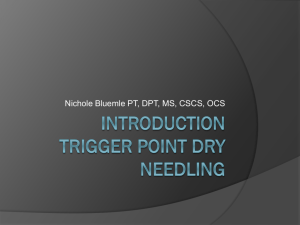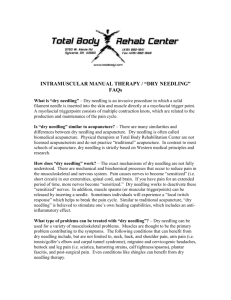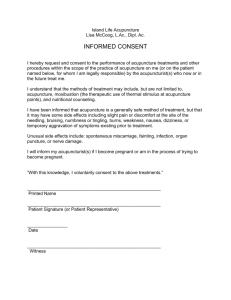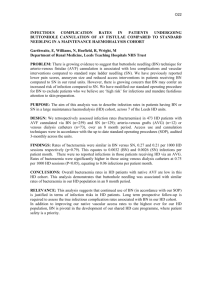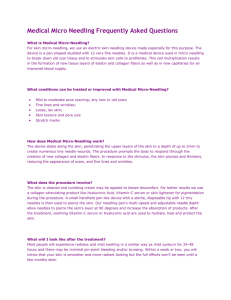Physiologic Effects of Dry Needling
advertisement
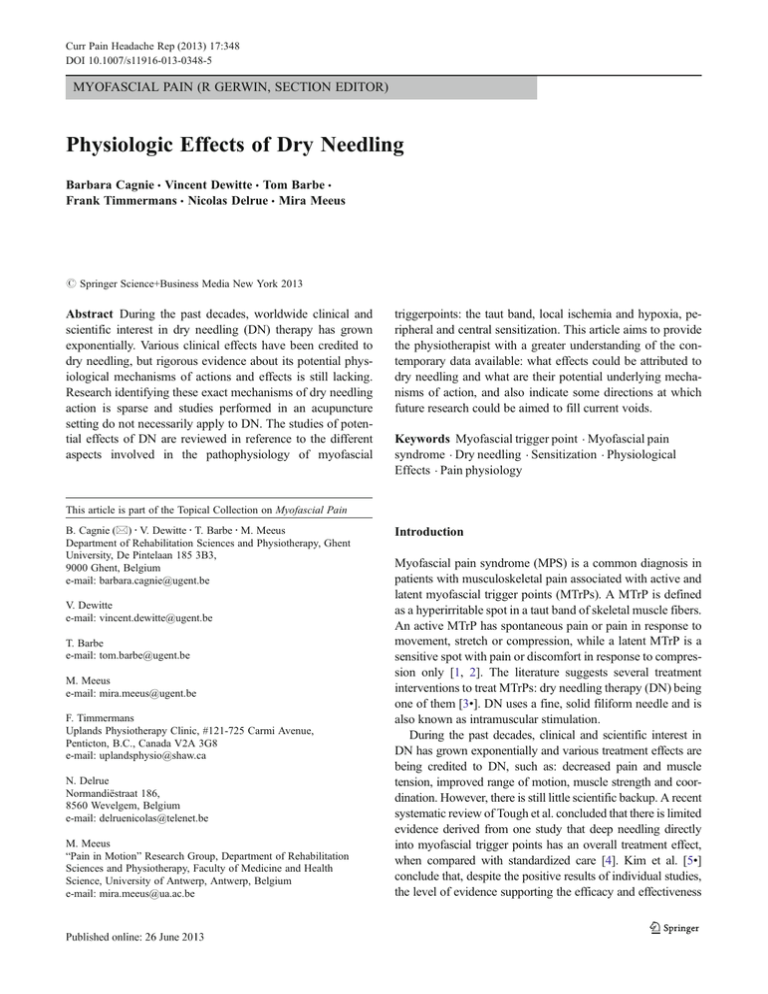
Curr Pain Headache Rep (2013) 17:348 DOI 10.1007/s11916-013-0348-5 MYOFASCIAL PAIN (R GERWIN, SECTION EDITOR) Physiologic Effects of Dry Needling Barbara Cagnie & Vincent Dewitte & Tom Barbe & Frank Timmermans & Nicolas Delrue & Mira Meeus # Springer Science+Business Media New York 2013 Abstract During the past decades, worldwide clinical and scientific interest in dry needling (DN) therapy has grown exponentially. Various clinical effects have been credited to dry needling, but rigorous evidence about its potential physiological mechanisms of actions and effects is still lacking. Research identifying these exact mechanisms of dry needling action is sparse and studies performed in an acupuncture setting do not necessarily apply to DN. The studies of potential effects of DN are reviewed in reference to the different aspects involved in the pathophysiology of myofascial triggerpoints: the taut band, local ischemia and hypoxia, peripheral and central sensitization. This article aims to provide the physiotherapist with a greater understanding of the contemporary data available: what effects could be attributed to dry needling and what are their potential underlying mechanisms of action, and also indicate some directions at which future research could be aimed to fill current voids. Keywords Myofascial trigger point . Myofascial pain syndrome . Dry needling . Sensitization . Physiological Effects . Pain physiology This article is part of the Topical Collection on Myofascial Pain B. Cagnie (*) : V. Dewitte : T. Barbe : M. Meeus Department of Rehabilitation Sciences and Physiotherapy, Ghent University, De Pintelaan 185 3B3, 9000 Ghent, Belgium e-mail: barbara.cagnie@ugent.be V. Dewitte e-mail: vincent.dewitte@ugent.be T. Barbe e-mail: tom.barbe@ugent.be M. Meeus e-mail: mira.meeus@ugent.be F. Timmermans Uplands Physiotherapy Clinic, #121-725 Carmi Avenue, Penticton, B.C., Canada V2A 3G8 e-mail: uplandsphysio@shaw.ca N. Delrue Normandiëstraat 186, 8560 Wevelgem, Belgium e-mail: delruenicolas@telenet.be M. Meeus “Pain in Motion” Research Group, Department of Rehabilitation Sciences and Physiotherapy, Faculty of Medicine and Health Science, University of Antwerp, Antwerp, Belgium e-mail: mira.meeus@ua.ac.be Introduction Myofascial pain syndrome (MPS) is a common diagnosis in patients with musculoskeletal pain associated with active and latent myofascial trigger points (MTrPs). A MTrP is defined as a hyperirritable spot in a taut band of skeletal muscle fibers. An active MTrP has spontaneous pain or pain in response to movement, stretch or compression, while a latent MTrP is a sensitive spot with pain or discomfort in response to compression only [1, 2]. The literature suggests several treatment interventions to treat MTrPs: dry needling therapy (DN) being one of them [3•]. DN uses a fine, solid filiform needle and is also known as intramuscular stimulation. During the past decades, clinical and scientific interest in DN has grown exponentially and various treatment effects are being credited to DN, such as: decreased pain and muscle tension, improved range of motion, muscle strength and coordination. However, there is still little scientific backup. A recent systematic review of Tough et al. concluded that there is limited evidence derived from one study that deep needling directly into myofascial trigger points has an overall treatment effect, when compared with standardized care [4]. Kim et al. [5•] conclude that, despite the positive results of individual studies, the level of evidence supporting the efficacy and effectiveness 348, Page 2 of 8 of DN for several conditions remains insufficient, because of concerns about a lack of precision and a high risk of bias of the studies. Rigorous large-scale, placebo controlled, clinical trials are needed to evaluate the clinical utility of this technique [4, 5•]. This article reviews the current state of knowledge of physiologic effects of DN by an in-depth review of basic and clinical research that has been published. First, a general overview of pain pathways and modulation of the pain perception is provided, as this should be the basis and reasonable rationale for all therapeutic interventions, including DN. Second, after giving a short overview of the pathophysiology of MTrPs, the different underlying mechanisms of DN are described in reference to the different aspects involved in the pathophysiology of MTrPs. These findings are then critically discussed. We hope to provide the therapist with a better understanding of the contemporary data available and what effects could be attributed to DN, what their potential underlying mechanisms of action are and the directions that future research could be aimed at to fill in the current voids. Pain Physiology Pain sensations originate mainly in two types of pain receptors: low-threshold nociceptors that are connected to fast conducting aδ-fibers, and high-threshold nociceptors that conduct impulses through slower unmyelinated C-fibers. Central terminals of these sensory fibers enter the central nervous system (CNS) through the dorsal horn of the spinal cord, where they connect with spinal neurons via synaptic transmission. Neurons of superficial laminae I and deep laminae V project along the spinothalamic and spinoreticulothalamic tracts to supraspinal sites such as the thalamus, parabrachial nucleus, and amygdala, where pain signals are further processed and sent on to higher cortical centers [6]. Peripheral Pain Modulation Peripheral activation of Aδ- and C-fibre nociceptors is modulated by a number of sensitizing and algogenic agents, such as substance P (SP), bradykinin, histamine, calcitonin generelated peptide (CGRP), prostaglandins, interleukin-1β (IL1β), tumor necrosis factor (TNF), and nerve growth factor (NGF). All of these can be released following cellular damage [6]. The local release of some of these chemicals (SP, histamine) causes inflammation and vasodilation, contributing to the “protective” function of pain [6, 7]. Central Pain Modulation The sensation of pain is not only subject to modulation during its ascending transmission from the periphery to the Curr Pain Headache Rep (2013) 17:348 cortex, but also to spinal modulation and descending control from higher neurological centres. An important mechanism in the modulation of pain perception is segmental inhibition, which is the modified “gate theory of pain control”, first published by Melzack and Wall in 1965. This hypothesis describes how activation of Aβfibres can lead to an inhibition in the spinal cord by blocking the synaptic transmission between the Aδ- and C-fibres and the cells in the dorsal horn, because of the slower information transmission of the latter [6]. Another possible mechanism of pain modulation is through the endogenous opioid system. It is well known that the three main groups of opioid peptides: β-endorphin, enkephalins and dynorphines, and their μ-, δ- and κreceptors are widely distributed in peripheral primary afferent terminals and areas of the central nervous systems related to nociception [6]. The analgesic effects of opioids arise from their ability to inhibit directly the ascending transmission of nociceptive information from the spinal cord dorsal horn. They are also able to activate pain control circuits that descend from the midbrain [periaqueductal gray (PAG)], via the rostral ventromedial medulla (RVM) to the spinal cord dorsal horn [7]. Besides the endogenous opioids as important neurotransmitters in the descending pain control system, serotonin (5HT) and noradrenaline are the two other, most familiar and well investigated, transmitters of this pathway. However, descending projections containing dopamine (monoamine) and many other neurotransmitters can also play a crucial role in pain modulation [8]. Chronic Pain—Central Sensitization In conditions with chronic pain, the balance in pain modulation can be disturbed due to impaired pain inhibition and/or enhanced pain facilitation. This may lead to “centralsensitization”. Central sensitization entails altered sensory processing in the brain, increased spontaneous activity of dorsal horn neurons, dysfunctional endogenous analgesia, expansion of receptive field sizes, reduction in threshold, prolonged after-discharges, and increased activity of brain-orchestrated facilitatory pathways, which augment nociceptive transmission [8–12]. Central sensitization results in enhanced nociception (hyperalgesia) and pain elicited by normally non-noxious stimuli (allodynia) [7, 12]. Also, altered states of diffuse noxious inhibitory control (DNIC) have been associated with central sensitization in chronic pain patients [13–15]; often now referred to as “conditioned pain modulation” (CPM). CPM is a “pain-inhibits-pain” paradigm and occurs when two noxious stimuli are applied heterotopically, i.e., a second nociceptive stimulus is applied in a more remote location, outside the receptive field of the first. This second nociceptive stimulus (such Curr Pain Headache Rep (2013) 17:348 as heat, high pressure or electric stimulation) will be processed by the dorsal horn wide dynamic range neurons and can lead to inhibition of the first one. Central sensitization can also be enhanced and maintained by supraspinal processes involving cognitions, attention, emotions and motivation. These forebrain products can make a significant contribution to the clinical pain experience in, e.g., MPS and are referred to as cognitive emotional sensitization [16–18]. Pathophysiology of MTrPs In order to understand the underlying mechanisms of DN, some knowledge of the pathophysiology of MTrPs is helpful [1, 2]. The most credited local hypothesis for primary MTrP formation is the hypothesis first put forward by Simons et al. [19] and later expanded by Gerwin et al. [20]. They suggest that the first phase of trigger point formation consists of the development of a taut band as a result of abnormal endplate potential caused by excessive acetylcholine (ACh) release in the neuromuscular junction at the motor endplates [19, 21••]. EMG studies show this as ‘spontaneous electrical activity’ (SEA), also called ‘endplate noise’. MTrP irritability can be objectively assessed with the prevalence or amplitude changes of SEA that are recorded in this region [22]. It is further hypothesized that, due to this excessive ACh release at the motor endplate, sustained sarcomere contractures occur, that could lead to local ischemia and hypoxia. Consequently, vasoactive and algogenic substances are released that can sensitize peripheral nociceptors (peripheral sensitization). Sustained peripheral nociceptive input might sensitize dorsal horn neurons and supraspinal structures, leading to hyperalgesia and allodynia, as well as referred pain (central sensitization) [21••, 23–25]. Physiological Effects of Dry Needling There is some emerging DN research, but the exact mechanisms of action of direct needling in the deactivation of trigger points are not yet unraveled. Also, most of our current understanding of the systemic physiologic effects of DN is (in)directly derived from acupuncture literature [26••, 27••, 28]. Indeed, there are some similarities between acupuncture and DN, but, more importantly, many significant differences. Not just in the underlying philosophies and explanation models, but also in the ‘technical’ details: one of more needles applied, the movement of the needle, the depth of needle insertion, the amount and force of stimulation and the elicitation of a ‘local twitch response’ (LTR). A LTR is an involuntary spinal reflex resulting in a localized Page 3 of 8, 348 contraction of affected muscle fibers that are being manually stretched, injected or dry needled. According to Hong et al. [29], DN is most effective when these LTRs are elicited. Clinical results from Ceccherelli et al. [30] demonstrated that deep stimulation had a better analgesic effect when compared with superficial stimulation. It seems obvious to expect different results from superficial or deeper insertion. Deeper insertion of the needle affects several structures: skin, fascia, and muscle layers, whereas superficial insertion affects merely the skin and some superficial layers. Itoh et al. [31] have demonstrated this principle in several other studies, too, and conclude that the depth of needle penetration is important for the relief of muscle pain. The potential effects of DN will now be reviewed in reference to the four different aspects involved in the pathophysiology of MTrPs: the taut band, local ischemia and hypoxia, peripheral and central sensitization. An overview of the potential DN physiological effects is shown in Fig. 1. Effects on the Taut Band A statement that is often found in MPS papers and textbooks is “the effectiveness of DN probably lies in the mechanical disruption of the integrity of dysfunctional endplate”[19, 32]. To the best of our knowledge, basic research has not yet demonstrated an actual mechanical disruption of the endplate in recent studies. It has been demonstrated that DN may influence the SEA by eliciting a LTR. Both Chen et al. [33] and Hsieh et al. [34] demonstrated in their studies that DN to a MTrP region could effectively suppress SEA, when LTRs were elicited. They suggest that the insertion of a needle at the endplate region may lead to increased discharges and thereby immediately reduce available ACh stores, leading to a lesser SEA. Another working mechanism could be that sufficient mechanical needling activation around the endplate area causes muscle fibers to discharge and thus elicit a LTR. Baldry [35] mentioned that a LTR causes alterations in the length and tension of the muscle fibers and stimulates mechanoreceptors like the Aβ-fibers. Effects on Blood Flow As previously mentioned, sustained contractures of taut muscle bands might cause local ischemia and hypoxia in the core of the MTrPs. Different studies have demonstrated that needling may increase muscle blood flow and oxygenation [36–42]. Several mechanisms have been suggested to explain the local muscle response of blood flow in needle stimulation. The most plausible one is the release of vasoactive substance, such as CGRP and SP which, upon activation of Aδ- and C-fibers via the axon 348, Page 4 of 8 Curr Pain Headache Rep (2013) 17:348 Fig. 1 Schematic diagram of the potential physiological effects of DN. reflex, leads to vasodilatation in small vessels and increased blood flow [43]. There is a discrepancy in the literature whether this increase in blood flow is restricted to the needling site or if vasodilatation and increases in blood flow also extend beyond the site of stimulation (see “remote effects”). Some studies have demonstrated remote circulatory effects with needling [37], whereas others did not show an increase in blood flow at distant sites of the needling [36, 42]. Sandberg et al. [37] did find a transient significant increase in contralateral blood flow in the trapezius muscle after needle stimulation. However, this increase was significantly less than in the stimulated muscle and apparently only there for the first two minutes after the needle stimulation. In a recent study by Hsieh et al. [44••] they found an increase in a number of hypoxic-responsive proteins, including hypoxia-inducible factor-1α (HIF-1α), inducible isoform of nitric oxice synthases (iNOS) and vascular endothelial growth factor (VEGF) production in the biceps femoris muscle after DN stimulation. These proteins can promote angiogenesis, vasodilation, and altered glucose metabolism in hypoxic tissues. Repeated localized DN may thus upregulate the expression of HIF-1, iNOS, and VEGF proteins, and potentially increase capillarity in the skeletal muscle and improve the circulation in muscles containing MTrPs. However, long(er) term follow-up studies are needed as the effects on circulation beyond 5 days remain unclear. Neurophysiological Effects: Effects on Peripheral Sensitization Shah et al. [45, 46] found that the concentrations of SP and CGRP were higher in the vicinity of active MTrPs compared to latent ones or normal muscle tissue. After a LTR was elicited, SP and CGRP concentrations were significantly lowered compared to their pre-LTR values. These results were consistent with the data of Hsieh et al. [44••]. The data obtained from their study showed that a single session treatment produced a short-term analgesic effect by decreasing the Curr Pain Headache Rep (2013) 17:348 SP at peripheral sites, however, no lasting effect was observed 5 days after DN. In contrast, five consecutive sessions (one per day) of DN, increased the SP levels immediately after the needling and was maintained 5 days after the DN. This was accompanied by higher levels of TNF-α, iNOS, HIF-1, COX-2 and VEGF. Studies have demonstrated that increased COX-2 and TNF levels are associated with muscle damage [47]. It is likely that the five sessions of DN accumulated to an excessive level of intramuscular manipulation and caused damage in the fibers with noxious inputs (C-fibers) and increased release of SP. Secondly, peripheral opioid analgesia has received considerable attention as an endogenous pathway of inhibiting pain, mainly in the acupuncture literature, although clear mechanisms remain elusive. Hsieh et al. [44••] have also shown that increased β-endorphin levels can suppress neurons from releasing SP and thus inhibit pain transmission [44••]. Using an animal model, they demonstrated that one session of DN in the biceps femoris enhanced the betaendorphin levels in the biceps muscle and serum immediately after needling, but no lasting effect was observed 5 days after the needling. In contrast, the five consecutive sessions of DN reversed this effect. Neurophysiological Effects: Effects on Central Sensitization According to Chou et al. [26••], the most likely mechanism of pain relief through needle stimulation is hyperstimulation analgesia, which was originally proposed by Melzack [48]. DN may stimulate, both large myelinated fibers (i.e., Aβand Aδ-fibers), as well as C-fibers, indirectly via the release of inflammatory mediators. As a result of mechanical stimulation, Aβ- and Aδ-fibers are both activated and send afferent signals to the dorsolateral tracts of the spinal cord and could activate the supraspinal and higher centres involved in pain processing. Different mechanisms can occur, either in isolation or concurrently. Segmental Inhibition/Gate Control Chu [49] stated that, when an needle is rapidly thrust into a MTrP, the LTRs evoked lead to a large diameter-sensory afferent proprioceptive input into the spinal cord. This could have a “gate-controlling” effect of blocking the intra-dorsal horn passage of noxious information generated in the MTrP’s nociceptors. Srbely et al. [50] identified an immediate increase in the pain pressure threshold (PPT) at the infraspinatus MTrP, compared with the gluteus medius point, at 3 and 5 minutes after DN the infraspinatus muscle. They hypothesized that site-specific DN may be mediated by segmental inhibitory effects, evoked by selective stimulation of large myelinated fibers in the MTrP. Page 5 of 8, 348 It has been proposed that “satellite or secondary” MTrPs may develop in the referred pain zone from “key or primary” MTrPs. Hsieh et al. [51] conducted a clinical study and provided evidence that DN-evoked inactivation of a primary (key) MTrP inhibited the activity in ipsilateral secondary (satellite) MTrPs situated in its referral pain zone. FerandezCarnero et al. [52] showed that an increased nociceptive activity at latent MTrPs in the infraspinatus muscle increased motor activity and sensitivity of a MTrP in distant muscles connected to the same segmental level. Release of Endogenous Opioids Knowledge of the central effects of DN upon opioid release is limited. Using functional magnetic resonance imaging, Niddam et al. [53] showed that pain following the insertion of a needle into a trigger point, combined with electrical stimulation, is mediated through the PAG in the brainstem. The PAG is a central part of the opioid circuitry that controls nociceptive transmission at the level of spinal cord and cortex [8]. The change in PAG-activity was correlated with the change in PPT. It is hypothesized that DN, via stimulation of the nociceptive fibers, may activate the enkephalinergic inhibitory dorsal horn interneurons. It is unclear whether the needle manipulation or the electrical stimulation is responsible for these results or both. This combination, being “electro-acupuncture”, is also mentioned in clinical studies on acupuncture-induced analgesia and laboratory results report endogenous opiate peptides to be involved. Effect on the Release of Neurotransmitters: Serotonin and Noradrenaline Stimulation of Aδ-nerve fibers may also activate the serotonergic and noradrenergic descending inhibitory system. Although there are no known specific experimental or clinical studies supporting the proposed serotonergic and noradrenergic mechanisms of DN, it is hypothesized that DN may have an effect on both systems, often based again on acupuncture literature [27••]. Shah et al. [45, 46] found that the concentration of 5-HT and noradrenaline, was higher in the vicinity of active MTrPs compared to latent MTrP or normal muscle tissue. 5-HT receptors are primarily pronociceptive in the periphery, acting directly on afferent nerves and indirectly by release of other mediators (e.g., SP and glutamate). Conditioned Pain Modulation Patients with chronic musculoskeletal pain have impaired CPM. Depressed CPM will lead to a reduction of endogenous pain inhibition and can contribute to a chronic pain 348, Page 6 of 8 state [13]. Several reviews have hypothesized that needling may affect CPM [27••]. However, recent findings in both healthy and whiplash-patients have demonstrated that CPM on temporal summation of pressure pain did not respond to acupuncture needling [54, 55]. Remote Effects Different studies have investigated the remote effects of DN, both ‘distal to proximal’ effects and contralateral effects. Tsai et al. [56] and Fu et al. [22] both found that DN of a distal MTrP could provide a remote effect to reduce the irritability of a proximal MTrP. The literature is conflicting with respect to contralateral effects. Hsieh et al. [34] did find contralateral effects in an animal study, whereas Fu et al. [22] did not find these. The neural pathway for the remote effects appears to be mediated via a spinal reflex, which depends on an intact afferent pathway from the remote stimulating site to the spinal cord and normal spinal cord function at the level corresponding to the innervations of the proximally affected muscle [34]. It is further hypothesized that the remote effects may relate to a consequence of CPM, but firm evidence is lacking [26••]. Placebo Effects It is well known that expectation can significantly modulate pain perception, a mechanism frequently referred to as placebo analgesia [57]. Neuroimaging data demonstrate that placebo analgesia recruits subcortical and opioid sensitive brain regions, also involved in pain perception (including PAG, rostral anterior cingulate cortex, thalamus, insula, amygdala, and in some studies the prefrontal cortex). Many of these areas overlap with those modulated by needling. Functional magnetic resonance studies have confirmed that expectancy can influence acupuncture analgesia [58]. Obviously, placebo effects have to be considered when designing and conducting DN studies. Discussion DN has become a popular treatment technique with an increasing amount of studies demonstrating its clinical effects. Rigorous evidence about its physiological mechanisms of actions and effects is needed now in order to start supporting it as evidence based practice. The difficult methodological characteristics related to experimental studies and the complex network in pathological conditions may certainly account for this lack of research so far. Direct comparison between existing needling studies is difficult as the intervention parameters vary considerably Curr Pain Headache Rep (2013) 17:348 with respect to the methodological characteristics. It seems logical that mechanisms and effects of DN actions differ depending on: the location(s) of the needle placement(s), the depth of the insertion(s), the needle forces and motions used, and whether or not a LTR is elicited [59]. Most recommended clinical and research parameters are based on experts’ opinions. Recently, Davis et al. [60••] have developed an innovative device to quantify needling motion and force parameters in a treatment-like setting. Needling data can then subsequently be analyzed, providing a more objective method for characterizing needling in basic and clinical needling research. Studies are needed to identify optimal intervention parameters for DN. Further insights into the MPS’ pathophysiology mechanisms are welcomed, in order to find out more how pain modulation systems are being affected by it. Most of the existing studies on needling analgesia have focused on physiological pain in “normal” animals and human volunteers. However, current evidence points to far more complex pain mechanisms, especially in chronic pain patients. To better explore the mechanisms of analgesia, adequate models of chronic pain should be developed and applied in research. This may prevent scientists from an overexcited search for DN effects and explanation models, which might not be applicable given the complex modified circumstances in ‘real’ patients. When chronic pain and central sensitization are present, there is an increased responsiveness to a variety of peripheral stimuli. A general recommendation in these patients is to not increase pain during treatment, as any therapeutic intervention could serve as a new peripheral source of nociceptive barrage sustaining the process of central sensitization [12, 61]. DN activates several types of receptors, including nociceptors, and daily practice shows it is not always well tolerated in patients with central sensitization and therefore may not be a suitable choice. In a recent educational resource paper, published by the American Physical Therapy Association (February 2013), it is highlighted that severe hyperalgesia or allodynia may interfere with the application of DN. However, it should not be considered as an absolute contraindication. Several authors suggest in their reviews that treatment of concurrent MTrPs in, e.g., fibromyalgia should be systematically performed before any specific fibromyalgia therapy is undertaken [32]. Their idea is that any peripheral source of nociception should be removed before desensitization of the central nervous system can become the focus of the therapy. Conclusions We can conclude, after reviewing the current basic science findings, that the physiological mechanisms and effects of Curr Pain Headache Rep (2013) 17:348 DN are highly complex and recruit central and peripheral networks with physiologic and psychological responses. Results from studies performed in an acupuncture setting do not necessarily pertain to DN. Further insight in MPS and its pathophysiological mechanisms are needed, as well as studies investigating the exact biomechanical and neurophysiological mechanisms of action of DN in order to support its clinical evidence. To better explore the DN mechanisms of analgesia, adequate models of chronic pain should be developed and applied in research. There is still a long road ahead before the clinician has a well-constructed, evidence-based explanation model of DN. We hope this review will stimulate researchers to further explore the mechanisms and physiological effects of DN by conducting experiments that are both methodologically sound and clinically relevant. Compliance with Ethics Guidelines Conflict of Interest Dr. Barbara Cagnie reported no potential conflicts of interest relevant to this article. Mr. Vincent Dewitte reported no potential conflicts of interest relevant to this article. Mr. Tom Barbe reported no potential conflicts of interest relevant to this article. Mr. Frank Timmermans reported no potential conflicts of interest relevant to this article. Mr. Nicolas Delrue reported no potential conflicts of interest relevant to this article. Dr. Mira Meeus reported no potential conflicts of interest relevant to this article. Human and Animal Rights and Informed Consent This article does not contain any studies with human or animal subjects performed by any of the authors. References Papers of particular interest, published recently, have been highlighted as: • Of importance •• Of major importance 1. Hong CZ. Treatment of myofascial pain syndrome. Curr Pain Headache Rep. 2006;10(5):345–9. 2. Kuan TS. Current studies on myofascial pain syndrome. Curr Pain Headache Rep. 2009;13(5):365–9. 3. • Vulfsons S, Ratmansky M, Kalichman L. Trigger point needling: techniques and outcome. Curr Pain Headache Rep. 2012;16(5):407–12. In this review the authors provide an excellent update on last years’ advancements in basic science, imaging methods, efficacy, and safety of dry needling of MTrPs. 4. Tough EA, White AR, Cummings TM, et al. Acupuncture and dry needling in the management of myofascial trigger point pain: a systematic review and meta-analysis of randomised controlled trials. Eur J Pain. 2009;13(1):3–10. Page 7 of 8, 348 5. • Kim TH, Lee CR, Choi TY, et al. Intramuscular stimulation therapy for healthcare: a systematic review of randomised controlled trials. Acupunct Med. 2012;30(4):286–90. A total of 416 publications were initially collected and only 4 studies could be included in this review. This is showing the urgent need of rigorous large-scale clinical trials on dry needling. 6. Patel N. Physiology of pain. In: Patel N, Kopf A, editors. Guide to pain management in low-resource settings. 2010. p. 13–18. 7. Ossipov MH. The perception and endogenous modulation of pain. Scientifica. 2012;1–25. 8. Millan MJ. Descending control of pain. Prog Neurobiol. 2002;66(6):355–474. 9. Li J, Simone DA, Larson AA. Windup leads to characteristics of central sensitization. Pain. 1999;79(1):75–82. 10. Coderre TJ, Katz J, Vaccarino AL, et al. Contribution of central neuroplasticity to pathological pain: review of clinical and experimental evidence. Pain. 1993;52(3):259–85. 11. Staud R, Craggs JG, Robinson ME, et al. Brain activity related to temporal summation of C-fiber evoked pain. Pain. 2007;129(1–2):130–42. 12. Nijs J, Van Houdenhove B, Oostendorp RA. Recognition of central sensitization in patients with musculoskeletal pain: Application of pain neurophysiology in manual therapy practice. Man Ther. 2010;15(2):135–41. 13. Yarnitsky D. Conditioned pain modulation (the diffuse noxious inhibitory control-like effect): its relevance for acute and chronic pain states. Curr Opin Anaesthesiol. 2010;23(5):611–5. 14. Meeus M, Nijs J, Van de Wauwer N, et al. Diffuse noxious inhibitory control is delayed in chronic fatigue syndrome: an experimental study. Pain. 2008;139(2):439–48. 15. Ossipov MH, Dussor GO, Porreca F. Central modulation of pain. J Clin Invest. 2010;120(11):3779–87. 16. Zusman M. Forebrain-mediated sensitization of central pain pathways: 'non-specific' pain and a new image for MT. Man Ther. 2002;7(2):80–8. 17. Brosschot JF. Cognitive-emotional sensitization and somatic health complaints. Scand J Psychol. 2002;43(2):113–21. 18. Rygh LJ, Tjolsen A, Hole K, et al. Cellular memory in spinal nociceptive circuitry. Scand J Psychol. 2002;43(2):153–9. 19. Simons DG, Travell J, Simons LE. Myofascial pain and dysfunction: the trigger point manual. 2nd ed. Baltimore, MD: Williams and Wilkins; 1999. 20. Gerwin RD, Dommerholt J, Shah JP. An expansion of Simons' integrated hypothesis of trigger point formation. Curr Pain Headache Rep. 2004;8(6):468–75. 21. •• Ge HY, Fernandez-de-las-Penas C, Yue SW. Myofascial trigger points: spontaneous electrical activity and its consequences for pain induction and propagation. Chin Med. 2011;6:13. Excellent review and scientific update on the parts of the integrated triggerpoint hypothesis: the taut band, local and referred pain, peripheral and central sensitization. 22. Fu Z, Hsieh YL, Hong CZ, et al. Remote subcutaneous needling to suppress the irritability of myofascial trigger spots: an experimental study in rabbits. Evid Based Complement Alternat Med. 2012;2012:353916. 23. Mense S. How Do Muscle Lesions such as Latent and Active Trigger Points Influence Central Nociceptive Neurons? J Muscoskeletal Pain. 2010;18(4):348–53. 24. Gerwin R. Myofascial Pain Syndrome: Here We Are, Where Must We Go? J Muscoskeletal Pain. 2010;18(4):329–47. 25. Niddam DM, Chan RC, Lee SH, et al. Central representation of hyperalgesia from myofascial trigger point. NeuroImage. 2008;39(3):1299–306. 26. •• Chou LW, Kao MJ, Lin JG. Probable mechanisms of needling therapies for myofascial pain control. Evid Based Complement Alternat Med. 2012;2012:705327. ••Citing the several promising 348, Page 8 of 8 27. 28. 29. 30. 31. 32. 33. 34. 35. 36. 37. 38. 39. 40. 41. 42. 43. 44. scientific studies (i.e. electrophysiological, neurophysiological, and biochemical) that have revealed objective abnormalities in MTrP’s. The analgesic effect of needling is hypothesized to be related to immune, hormonal, and nervous systems. Compared to the slow-acting hormonal system, the nervous system acts in a faster manner. Given these complexities, needling analgesia cannot be explained by any single mechanism. •• Leung L. Neurophysiological basis of acupuncture-induced analgesia–an updated review. J Acupunct Meridian Stud. 2012;5(6):261–70. This article presents an up-to-date review of the various neurophysiologic mechanisms that have been proposed to produce acupuncture-induced analgesia. Zhao ZQ. Neural mechanism underlying acupuncture analgesia. Prog Neurobiol. 2008;85(4):355–75. Hong CZ. Lidocaine injection versus dry needling to myofascial trigger point. The importance of the local twitch response. Am J Phys Med Rehabil. 1994;73(4):256–63. Ceccherelli F, Rigoni MT, Gagliardi G, et al. Comparison of superficial and deep acupuncture in the treatment of lumbar myofascial pain: a double-blind randomized controlled study. Clin J Pain. 2002;18(3):149–53. Itoh K, Minakawa Y, Kitakoji H. Effect of acupuncture depth on muscle pain. Chin Med. 2011;6(1):24. Giamberardino MA, Affaitati G, Fabrizio A, et al. Effects of treatment of myofascial trigger points on the pain of fibromyalgia. Curr Pain Headache Rep. 2011;15(5):393–9. Chen JT, Chung KC, Hou CR, et al. Inhibitory effect of dry needling on the spontaneous electrical activity recorded from myofascial trigger spots of rabbit skeletal muscle. Am J Phys Med Rehabil. 2000;80(10):729–35. Hsieh YL, Chou LW, Joe YS, et al. Spinal cord mechanism involving the remote effects of dry needling on the irritability of myofascial trigger spots in rabbit skeletal muscle. Arch Phys Med Rehabil. 2011;92(7):1098–105. Baldry P. Acupuncture, trigger points and musculoskeletal pain. third ed. Churchill Livingstone; 2005. Cagnie B, Barbe T, De Ridder E, et al. The influence of dry needling of the trapezius muscle on muscle blood flow and oxygenation. J Manipulative Physiol Ther. 2012;35(9):685–91. Sandberg M, Larsson B, Lindberg LG, et al. Different patterns of blood flow response in the trapezius muscle following needle stimulation (acupuncture) between healthy subjects and patients with fibromyalgia and work-related trapezius myalgia. Eur J Pain. 2005;9(5):497–510. Sandberg M, Lundeberg T, Lindberg LG, et al. Effects of acupuncture on skin and muscle blood flow in healthy subjects. Eur J Appl Physiol. 2003;90(1–2):114–9. Sandberg M, Lindberg LG, Gerdle B. Peripheral effects of needle stimulation (acupuncture) on skin and muscle blood flow in fibromyalgia. Eur J Pain. 2004;8(2):163–71. Kubo K, Yajima H, Takayama M, et al. Changes in blood circulation of the contralateral achilles tendon during and after acupuncture and heating. Int J Sports Med. 2011;32(10):807–13. Kubo K, Yajima H, Takayama M, et al. Effects of acupuncture and heating on blood volume and oxygen saturation of human Achilles tendon in vivo. Eur J Appl Physiol. 2010;109(3):545–50. Ohkubo M, Hamaoka T, Niwayama M, et al. Local increase in trapezius muscle oxygenation during and after acupuncture. Dyn Med. 2009;8:2. Sato A, Sato Y, Shimura M, et al. Calcitonin gene-related peptide produces skeletal muscle vasodilation following antidromic stimulation of unmyelinated afferents in the dorsal root in rats. Neurosci Lett. 2000;283(2):137–40. •• Hsieh YL, Yang SA, Yang CC, et al. Dry needling at myofascial trigger spots of rabbit skeletal muscles modulates the biochemicals associated with pain, inflammation, and hypoxia. Evid Based Curr Pain Headache Rep (2013) 17:348 45. 46. 47. 48. 49. 50. 51. 52. 53. 54. 55. 56. 57. 58. 59. 60. 61. Complement Alternat Med. 2012;2012:342165. The hypothesis that dry needling at MTrSs can modulate biochemicals associated with pain, inflammation, and hypoxia depending on the dry needling dosage is supported by this study. data. The findings clarify the biochemical mechanisms induced by dry needling. Dry needling at the MTrSs modulates various biochemicals associated with pain, inflammation, and hypoxia in a dose-dependent manner. Shah JP, Phillips T, Danoff JV et al. An in vivo microanalytical technique for measuring the local biochemical milieu of human skeletal muscle. J Appl Physiol. 2005;(8750–7587 (Print)). Shah JP, Gilliams EA. Uncovering the biochemical milieu of myofascial trigger points using in vivo microdialysis: an application of muscle pain concepts to myofascial pain syndrome. J Bodyw Mov Ther. 2008;12(4):371–84. Chiang J, Shen YC, Wang YH, et al. Honokiol protects rats against eccentric exercise-induced skeletal muscle damage by inhibiting NF-kappaB induced oxidative stress and inflammation. Eur J Pharmacol. 2009;610(1–3):119–27. Melzack R. Myofascial trigger points: relation to acupuncture and mechanisms of pain. Arch Phys Med Rehabil. 1981;62(3):114–7. Chu J, Schwartz I. The muscle twitch in myofascial pain relief: effects of acupuncture and other needling methods. Electromyogr Clin Neurophysiol. 2002;42(5):307–11. Srbely JZ, Dickey JP, Lee D, et al. Dry needle stimulation of myofascial trigger points evokes segmental anti-nociceptive effects. J Rehabil Med. 2010;42(5):463–8. Hsieh YL, Kao MJ, Kuan TS, et al. Dry needling to a key myofascial trigger point may reduce the irritability of satellite MTrPs. Am J Phys Med Rehabil. 2007;86(5):397–403. Fernandez-Carnero J, Ge HY, Kimura Y, et al. Increased spontaneous electrical activity at a latent myofascial trigger point after nociceptive stimulation of another latent trigger point. Clin J Pain. 2010;26(2):138–43. Niddam DM, Chan RC, Lee SH, et al. Central modulation of pain evoked from myofascial trigger point. Clin J Pain. 2007;23(5):440–8. Tobbackx Y, Meeus M, Wauters L et al. Does acupuncture activate endogenous analgesia in chronic whiplash-associated disorders? A randomized crossover trial. Eur J Pain. 2012. Schliessbach J, van der Klift E, Siegenthaler A, et al. Does acupuncture needling induce analgesic effects comparable to diffuse noxious inhibitory controls? Evid Based Complement Alternat Med. 2012;2012:785613. Tsai CT, Hsieh LF, Kuan TS, et al. Remote effects of dry needling on the irritability of the myofascial trigger point in the upper trapezius muscle. Am J Phys Med Rehabil. 2010;89(2):133–40. Lyby PS, Aslaksen PM, Flaten MA. Variability in placebo analgesia and the role of fear of pain–an ERP study. Pain. 2011;152(10):2405–12. Kong J, Kaptchuk TJ, Polich G, et al. An fMRI study on the interaction and dissociation between expectation of pain relief and acupuncture treatment. NeuroImage. 2009;47(3):1066–76. Langevin HM, Wayne PM, Macpherson H, et al. Paradoxes in acupuncture research: strategies for moving forward. Evid Based Complement Alternat Med. 2011;2011:180805. •• Davis RT, Churchill DL, Badger GJ, et al. A new method for quantifying the needling component of acupuncture treatments. Acupunct Med. 2012;30(2):113–9. Needling motion and force parameters can be quantified in a treatment-like setting. Needling data can subsequently be analysed, providing an objective method for characterising needling in basic and clinical acupuncture research. Nijs J, Van Oosterwijck J, De Hertogh W. Rehabilitation of chronic whiplash: treatment of cervical dysfunctions or chronic pain syndrome? Clin Rheumatol. 2009;28(3):243–51.
